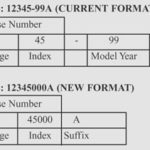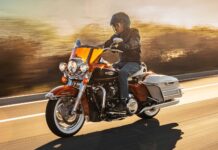The old adage is that those who fail to learn from the past are condemned to repeat it. I’m not so sure.
I suppose the first of many reasons is because, where Harley is concerned, there simply is no precedent for what they are doing these days.
Rewind! Let me say at this point, you might find it instructive to ask your friendly local parts man for the opportunity to inspect his selection of parts books. No, not for the one that covers your particular passion. But to take the entire collection in, and look for the insights they might offer, to the individual who’s willing to see… what others only look at.
Lets begin with the Sportster parts books. We generally have the Iron Sportster models, broken into rather broad eras. In fact, there’s a lesson or two in the very first one. Most early Sporty catalogs cover 1954–1978. (Funny, when you consider that the Sportster didn’t exist until 1957!) Never mind that for now, ‘cause we’re dealing with the second book, which covers 1979-1985, the end of a run that lasted 28 years. Two books, 28 years, one model!
Now, we’re at 1986 and the first Evo Sportster. This one can be broadly sliced into two categories. The final four-speed Sportys, produced from 1986 to 1990, then five-speeds, from 1991 to 2003. Lessee… that’s two books, two models (or versions of the same model if you prefer), and 16 years. Lastly, we arrive at the rubber-mount models 2004 and counting, and—surprise!—a parts book for every single model year. The demarcation in these bikes is the switch from carbs-only to EFI-only, starting in 2007.
Those of a more liberal bent, likely to count a five-speed transmission as enough to constitute a new model, would then need to allow that Buells, with their rubber- mounted ride and astounding chassis, are really yet another… more sporty… Sporty. Adding them to the ledger (and the parts book rack) would mean a model range that first appeared in 1994, and proliferated! Counting two already-extinct models of the marque (the S2 Thunderbolt and S1 Lightning) and not counting variants like the White Lightning still leaves the S3, M2, and X1. That suddenly makes five books, five models in nine years! Then there’s the alloy beam frame Buells (as distinct from the tube frame) commencing in 2003 and involving as many or more new parts books, because of all the new parts.
See the trend? Let’s look at Big Twins.
FL Dressers from 1941 to 1984 are covered in one volume in your dealer’s rack. That represents 43 years of Knucks, Pans and Shovels. OK, I’ll grant that even to the casual observer, this book isn’t much more than Cliff Notes for anything much older than the ’70s. But… we next have the original FX parts book—Shovelheads only! Matter of fact, alternator-equipped Shovels running from 1971 thru 1984. There’s a scant 13 years covered by that one. Still, the count is two books covering Big Twins for over four decades! The only big deal in these Big Twins is the jump in displacement from 74 inches to 80 inches in the late ’70s. Oh yeah… and the introduction of the rubber-mount stuff, the Dresser FLTs and the svelte undressed FXR, in 1980 and 1982 respectively. The rack has swelled to four versions of Shovelhead Big Twins by 1984.
However, we have arrived at the era of the Evo, also initiated in 1984. The parts books begin to proliferate pretty seriously at this point. Back then H-D decided to let each Evo model have its own book. That’s FLT, FX, FXR, plus the latest and greatest of the era… the FXST Softail. (OK, truth is H-D stuck FX and FXST in the same book from 1984-1986.) Point is, in addition to the books we’ve covered, the rack includes three more… all in one model year!
You keepin’ score yet? I hope so, because there will be a quiz, and with any luck a revelation or two as well, if you’ll hang in.
Things are still pretty manageable in the ol’ book rack but H-D’s a little worried, so they decide since the Shovel has gone to its rest (and unlike the Evo, got no sympathy from the factory after its demise) to combine all Big Twins into one volume starting in 1987. Most shops nowadays carry a volume that reads 1987-1990, covering a range that, by now, is getting a little bewildering. I mean, at this point, there’s the Heritage, Fat Boy, FX Softails, various FXRs, FLTs galore and the whole thing is repeated in the next tome, covering 1991-1993, and yet another for 1994-95 models. Three parts books for eight years of Big Twins. Then—the turnabout!
Since 1996, the factory has gone with an individual parts book for each line of Big Twin. With one for Dyna, Touring, Softail and Sporty, every year since (not to mention special volumes for police bikes and Screamin’ Eagle CVOs) this policy certainly added clutter to parts book racks, and presumably clarity to a seeker of the right part for the specific machine involved.
Oh! Notice what’s happened to the Genuine Parts and Accessories catalog as well? Once upon a time a mere pamphlet of a few dozen pages, the damn thing has grown to the size of a phone book for a mid-western metropolis. Several hundreds of pages of bling, doo-dads, even essential items like oil and filters—thick with options and heavy enough that you wouldn’t want to drop it on your foot, and almost all of it happening in the last dozen years.
The point to be made is apparent: Proliferation produces profound production of parts! Yes, sports fans, we now have so many factory parts and pieces (with far more to come), The Motor Company’s existing system for keeping track of them is in danger of imminent collapse. After all, we all know the parts game is played with numbers. Numbers for everything from pistons and rings to the screws that hold on that chrome widget you just installed. What happens when you have so much stuff you run out of numbers to keep track of all of it?
In Harley-Davidson’s case, you scrap the system you’ve been using since all those parts books on your dealers rack were printed. What I mean to say is, the parts numbering system the factory has used since before most of us could ride is going away in December of this year. More accurately, they are phasing it out, in favor of a new methodology that will allow them to assign even more numbers to ever more stuff. Necessary to be sure, but in many ways, the gradual loss of the old numbering is to be lamented.
You see, there was a certain charm inherent in the old way of identifying a Harley part, based in no small part on the way it was numbered. For those who may not know the basics, I offer this crude (and by no means comprehensive or inclusive) “primer:”
Part Number Classifications
1-13999 Hardware and common items. (terminals, clamps, seals, bearings)
14000 Labels, decals
16000 Engine, cylinders
17000 Rocker arms, rocker boxes, pushrods, tappets, gaskets
18000 Intake, exhaust valves and related parts
21000–22999 Pistons, rings, piston pins
23000 Flywheels, connecting rods
24000–25499 Crankcases
25500–25999 Camshafts, gear case components
26000 Oil pumps, gears
27000–28999 Carburetors, manifolds, breather components
29000 Generators, alternators
30000–32999 Ignition, engine electrics
33000 Transmission, gaskets, starters
34000 Transmission cases and covers
35000–37999 Transmission gears, shafts and related parts
38000–39999 Clutch and related parts
40000–40999 Chains, sprockets
41000–44999 Wheels, tires, axles, brakes, chain
45000–46000 Forks and related parts
47000–49000 Frames and related parts
50000 Jiffy stand
52000 Seats
53000 Luggage carriers, sissy bars and related parts
54000 Shock absorbers
55000 Handlebar and related parts
57000 Windshield and fairings
58000 Fenders, tour packs (OE)
60000–60499 Primary housings
60500-61999 Fuel tanks
62000–63999 Oil tank, filters, hoses
64000–64999 Exhaust systems
65000–66000 Battery, side covers
67000 Headlamp
68000 Tail lamp, directionals
69000 Headlamp trim, accessories
70000–72999 Speedos, tachs, chassis electrical
74000 Gauges
75000 Handlebar accessories
76000–77999 Radio, electronics
78000 (none–current)
79000 Fiberglass accessories
80000 Exhaust systems (Screamin’ Eagle)
81000 (none-current)
82000 Buell race kits and related parts
83000–85999 Tri-Glide, sidecar and related parts
86000 Sidecar bodies (painted)
87000 Sidecar body and related parts
88000 Sidecar chassis and related parts
90000 Saddlebags, luggage
91000–93000 Bumpers, protection, security, GPS, mirrors
94000 Chrome hardware, clocks, flags, saddlebag coolers
95000 Painted sheet metal accessories
96000 Clothing, trim
97000–98000 Riding gear, luggage, cargo nets, bungees, coin holders
99000–99999 Maintenance items, manuals, brochures, books, literature
Part Number Applications
Essentially, the model year the part was used for the first time. For instance, I seem to recall that there’s a woodruff key, still available, that has the model year part number “-18”, meaning it was first employed by the factory about the time we entered World War I. There are others that date back even further, some to 1911. On the other hand, most of the so-called Screamin’ Eagle exhaust pipes, though they’ve been around for over 20 years, got (ahem!) re-engineered in 2006. So finding an example with a model year “dash number” lower/older than -06 isn’t so easy. Harley also re-thought most of their line of control cables (clutch, throttle, etc) listed in the P&A catalog this year. These have a model year dash number (-09) that reflects this, even though these cables and hoses will fit bikes built a decade ago or more. Hopefully this points out that the H-D part number model year suffix (or dash number, as I call it) doesn’t necessarily tell you what years (or models) it will fit, only the year it was introduced.
Part Number Modifications
Invariably, an Alpha suffix to the dash number. Painted parts get three letters attached, presumably to identify them as items modified with color(s). “Standard” parts only get one if/when they are updated or modified. Some standard parts have been through five or six rounds of this treatment, getting yet another letter every time it happens. My favorite instance of this behavior is a primary gasket for long primary Big Twins (mostly four-speed) from the 1965 Panhead through to the 1988 Softail. This part (60539-81E) not only got its basic number changed in 1981 when primary covers got nine screw holes, but has been mildly modded no less than six times since! Yet, it will fit clear back to the eight-hole stuff from the ‘60s and ‘70s (which used to have, as you might imagine by now, -65 and other such model year suffixes) showing how flexible the numbering system has been. It also illuminates a bit of the sometimes arcane, sometimes critical, but surprisingly interesting history that goes with each and every component used to build Harleys.
But this will all change soon. Since the new numbering will not have any of this traditional information embedded in the number itself, whether it’s for better or worse is yet to be seen. Either way, it represents the passing of an era… and the path to a hell of lot of new parts!
Here’s the gist of it from the factory’s mouth:
May 04, 2009
To: All Worldwide Dealers
Subject: Renewing Our Legacy: New Part Number Format Coming in December
Dear Dealers:
As the Motor Company has grown, we’ve experienced tremendous increases in product families and product categories. The current part numbering format, developed in the early 1960s, can no longer support this growth, and if we do nothing, we will run out of base part numbers by 2012.
Therefore, beginning in December 2009, we will be upgrading to a new part number format that is flexible, adaptable and dependable—one that can carry us through to the next century. The new part number format will meet the changing needs of the Motor Company, Dealers and Suppliers.
What you need to know about this change:
- Current part numbers will not be changing; only newly assigned part numbers (beginning in December 2009) will receive the new format.
- You will begin to see the new part number format sometime in the first quarter of 2010; over time, you will see a gradual decrease in the current part number format as those parts become obsolete, and a steady increase in the new part number format as new products are added.
- General Merchandise and Buell part numbers will not change at this time.
- Component type (what a part is, i.e. bolt) and model year introduction attributes will be available with the new part number format. While not imbedded in the number, you will be able to see the component type and model year introduction attributes on labels, in parts books, and in most Dealer Management Software screens.
- We are committed to keeping you informed and providing the necessary resources to you throughout this transition.
- What will the new part number look like? The current part number format includes a five digit base number followed by a dash (-), then the model year, for a total of eight characters (plus a suffix, in some cases). The new part number format also has just eight characters: an eight digit base number, no dash, and no model year designation. Therefore, the length of the part numbers will not change.
Here is an example to illustrate the differences:






















